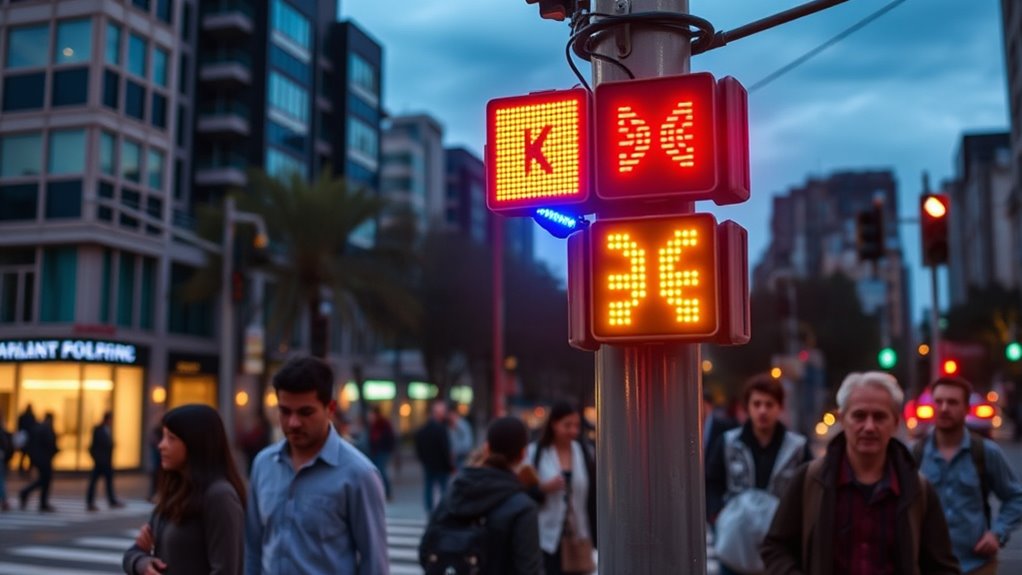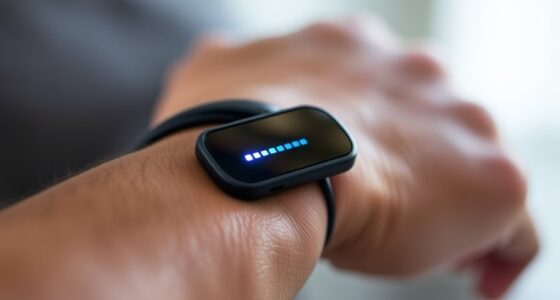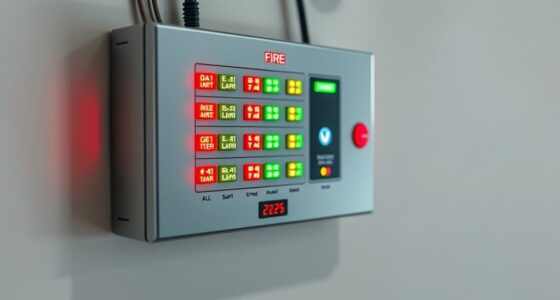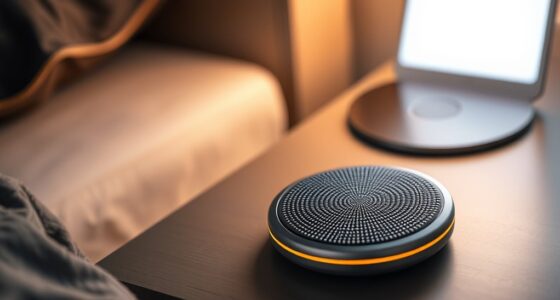Traditional sirens and alarms often miss warning deaf individuals during emergencies, creating safety gaps. To address this, innovations like flashing lights, digital displays, and vibrating devices are being integrated into public alerts. Designing inclusive strategies involves visual symbols, sign language visuals, and tactile cues to guarantee everyone receives timely information. Cities and transit systems are making progress with these solutions. Keep exploring to discover how future technologies may further improve safety for everyone.
Key Takeaways
- Integrate flashing lights, digital displays, and vibrations into emergency alerts to ensure deaf individuals receive timely notifications.
- Incorporate sign language visuals and symbols into public warning systems for immediate, universal understanding.
- Develop standardized visual alert protocols adaptable across various devices and environments for consistency.
- Use multi-sensory alerts combining visual, tactile, and auditory cues to accommodate diverse needs.
- Promote inclusive design principles and real-time digital sign language interpreters to enhance accessibility during emergencies.
The Limitations of Traditional Emergency Warning Systems

Traditional emergency warning systems often rely on auditory signals like sirens, alarms, or radio broadcasts, which can be ineffective for deaf and hard-of-hearing individuals. This auditory reliance means those with hearing impairments might miss critical alerts, putting them at higher risk during emergencies. Additionally, repeated loud alarms can lead to alarm fatigue, where people become desensitized or overwhelmed, reducing their responsiveness. When alerts depend solely on sound, it creates a gap in safety for the deaf community. You may not hear sirens or alarms, leaving you unaware of danger. This limitation highlights the need for alternative warning methods that do not depend exclusively on sound, ensuring everyone receives timely and effective alerts during emergencies. Incorporating visual safety alerts can significantly improve inclusivity and response times for all individuals. Employing advanced notification technology can further bridge the communication gap during crises, especially when integrated with emergency management systems.
Innovations in Visual Alert Technologies

To bridge the gap left by auditory warning systems, innovative visual alert technologies have emerged as essential tools for ensuring safety among deaf and hard-of-hearing individuals. These advances leverage assistive technology to deliver clear, immediate alerts through visual cues like flashing lights, digital displays, or vibrating devices. User-centered design plays a pivotal role, ensuring that the technology is intuitive, accessible, and effective in various environments. For example, smart alarm systems can sync with household lights or display alerts on personal devices, providing timely information during emergencies. By focusing on the needs of users, these innovations improve responsiveness and reduce danger. Incorporating multi-sensory alert methods can enhance effectiveness for diverse users. As technology evolves, these visual alerts become more integrated, reliable, and inclusive—creating safer communities for everyone.
Designing Inclusive Public Safety Communication Strategies

Creating effective public safety communication strategies requires intentional inclusion of diverse needs, especially for deaf and hard-of-hearing communities. You should incorporate multiple methods, like sign language visuals and clear color coding, to guarantee messages reach everyone. Use sign language videos or symbols to communicate warnings quickly, and employ contrasting colors—red for danger, yellow for caution—to draw attention. When designing your approach, consider the following:
| Method | Description | Benefits |
|---|---|---|
| Sign language | Visual gestures for immediate understanding | Clear communication for Deaf |
| Color coding | Using colors to signal danger or safety | Instant recognition |
| Text alerts | Written messages on displays or phones | Detailed info |
| Visual symbols | Icons representing hazards | Universal understanding |
| Vibrations | Tactile alerts for deaf individuals | Personal awareness |
Additionally, integrating innovative materials and communication methods, such as visual symbols, can further enhance accessibility and ensure that public safety messages are inclusive for all community members.
Case Studies: Successful Implementation of Visual Alerts

Many communities have successfully implemented visual alert systems that effectively keep deaf and hard-of-hearing individuals safe during emergencies. For example, some cities have integrated sign language into visual alerts, ensuring clear communication for those who rely on sign language. These systems often feature visual alert design elements like flashing lights, on-screen notifications, and color-coded signals that grab attention quickly. In one case, a public transit system added visual alerts with sign language interpreters displayed on screens during emergencies, making information accessible for all. Another community designed visual alerts with simple, universal symbols and bright flashing lights to enhance visibility. These examples show that combining thoughtful visual alert design with sign language integration creates effective safety measures, empowering deaf communities during crises. Additionally, incorporating eye-catching visual cues can further improve the effectiveness of these alerts by ensuring they capture attention immediately.
Future Directions for Accessible Emergency Notifications

Building on the success of current visual alert systems, future developments aim to make emergency notifications even more accessible and inclusive. You’ll see increased emphasis on sign language integration, ensuring deaf individuals receive real-time, understandable information through video or digital sign language interpreters. Improving visual alert standards is also a priority, with clearer, more consistent visuals that quickly convey urgency across different contexts. You might encounter standardized visual formats that are adaptable for various devices and environments, making alerts more effective everywhere. These advancements will foster better communication during emergencies, reducing delays and confusion. Incorporating visual communication standards and developmental milestones into alert design can help tailor messages to diverse audiences, ensuring everyone, regardless of hearing ability, receives timely, clear, and actionable safety information. Additionally, establishing inclusive design principles can further enhance the effectiveness of these alerts for all users.
Frequently Asked Questions
How Effective Are Visual Alerts Compared to Auditory Sirens?
You might find that visual alerts can be more effective than auditory sirens, especially since auditory limitations can prevent some people from hearing alarms. Visual recognition is immediate and accessible for many, reducing delays in response. While sirens work well for alerting the majority, adding visual cues guarantees everyone, including the deaf, receives timely warnings. Combining both methods maximizes safety and inclusivity for all community members.
What Are the Costs Associated With Implementing Visual Safety Alerts?
When considering the costs of implementing visual safety alerts, you should conduct a thorough cost analysis to understand expenses like technology, installation, and maintenance. Funding strategies are essential to cover these costs, such as government grants, public-private partnerships, or community funding. While initial investments might seem high, effective planning guarantees you create accessible safety systems that benefit everyone without overwhelming your budget.
How Do Visual Alerts Cater to Different Types of Disabilities?
Imagine a vibrant mosaic of safety, where signs and signals come together. Visual alerts can include sign language for those who prefer spoken language, and tactile signals for individuals with profound disabilities. You see, these adaptations guarantee everyone receives timely warnings, regardless of their specific needs. By incorporating sign language symbols and tactile cues, you create an inclusive safety system that reaches different types of disabilities effectively.
Are There Privacy Concerns With Visual Emergency Notification Systems?
You might wonder if visual emergency notifications raise privacy concerns. While they improve safety for everyone, including the deaf, there are surveillance concerns and data security issues to consider. You should guarantee that the systems are secure and that personal data isn’t misused or exposed. Transparency about how data is collected and protected helps build trust, ensuring that safety initiatives respect individuals’ privacy while providing vital alerts.
How Can Public Awareness Be Increased About Visual Safety Alerts?
Have you ever missed an alert because you didn’t see it? To boost awareness of visual safety alerts, you should focus on community engagement and technology integration. Host local workshops, spread information through social media, and partner with organizations serving the deaf community. By making these efforts visible and accessible, you’ll guarantee more people recognize and respond to alerts, creating a safer environment for everyone.
Conclusion
Think of public safety alerts as a lighthouse guiding all ships safely to shore. By embracing visual alerts, you guarantee no vessel is left in the dark, regardless of whether they hear the siren or not. Your efforts to innovate and include create a beacon of safety for everyone, illuminating the way forward. Together, you can transform emergency communication into a lighthouse that shines equally for all, steering communities safely through any storm.











